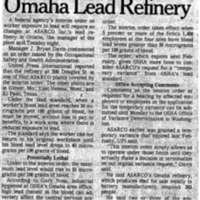Worker Protection at Omaha Lead Refinery
Dublin Core
Title
Worker Protection at Omaha Lead Refinery
Description
Some people most affected by Omaha’s lead smelter plant, Asarco, would have definitely been the workers who were often in close contact with the toxic, hazardous waste. In 1985, the Omaha World-Herald released an article about how the federal agency, the Occupational Safety and Health Administration (OSHA), was issuing an order to Asarco to protect the health of the people who worked there. Their strategy to protect workers was essentially that when workers' blood levels reached 50 micrograms of lead per 100 grams of blood that they are moved to a less hazardous workspace without reducing their pay. When the lead content dropped back down to 40 micrograms per 100 grams they could be returned to their previous working conditions.
In the second half of this article, Asarco agreed to take strides to protect the health of their employees by introducing more medical surveillance for them. In doing so, they did acknowledge the negative effect that lead had on people’s health. Still, Asarco asked for a variance, or exception from the order, as they wanted to be able to keep their most skilled workers in the most dangerous positions to maximize their performance or efficiency. They also claimed that it would be a safety risk to replace their most skilled workers with new people, as they would not be as good at the job and would have to be trained. While Asarco claimed that it was only 2-3 employees that were exposed to the worst of the lead, the effects of Asarco’s plant impacted people across the city of Omaha. By trying to find loopholes or be granted exceptions instead of acknowledging how terrible the effect of lead on people really was, Asarco helped curate a culture in which denial, in order to protect profits or efficiency, is valued over human health and the environment.
This article briefly explained how lead is not only known to be potentially dangerous but also it is known to be potentially lethal, which is why the ordinance was introduced. This article came out around 12 years before Asarco shut down and the EPA declared Omaha a Lead Superfund site. This again raises the question of why did it take so long for action to be taken towards lead remediation in Omaha? OSHA had already granted Asarco’s variance once the year before, so if they did grant it again it only added to the belief that things maybe are not as bad as they sounded. By minimizing the dangerousness of lead while simultaneously acknowledging that it is potentially lethal, the long road to lead remediation in Omaha is seen for what it is-- complicated, with much tension surrounding it. By addressing workers' safety, talks of the general population’s safety were bound to become more widespread, which did ultimately result in the remediation efforts that are in place today.
In the second half of this article, Asarco agreed to take strides to protect the health of their employees by introducing more medical surveillance for them. In doing so, they did acknowledge the negative effect that lead had on people’s health. Still, Asarco asked for a variance, or exception from the order, as they wanted to be able to keep their most skilled workers in the most dangerous positions to maximize their performance or efficiency. They also claimed that it would be a safety risk to replace their most skilled workers with new people, as they would not be as good at the job and would have to be trained. While Asarco claimed that it was only 2-3 employees that were exposed to the worst of the lead, the effects of Asarco’s plant impacted people across the city of Omaha. By trying to find loopholes or be granted exceptions instead of acknowledging how terrible the effect of lead on people really was, Asarco helped curate a culture in which denial, in order to protect profits or efficiency, is valued over human health and the environment.
This article briefly explained how lead is not only known to be potentially dangerous but also it is known to be potentially lethal, which is why the ordinance was introduced. This article came out around 12 years before Asarco shut down and the EPA declared Omaha a Lead Superfund site. This again raises the question of why did it take so long for action to be taken towards lead remediation in Omaha? OSHA had already granted Asarco’s variance once the year before, so if they did grant it again it only added to the belief that things maybe are not as bad as they sounded. By minimizing the dangerousness of lead while simultaneously acknowledging that it is potentially lethal, the long road to lead remediation in Omaha is seen for what it is-- complicated, with much tension surrounding it. By addressing workers' safety, talks of the general population’s safety were bound to become more widespread, which did ultimately result in the remediation efforts that are in place today.
Creator
Omaha World Harold
Source
Omaha World Harold
Publisher
Omaha World Harold
Date
July 10th, 1985
Contributor
Chelsea Greenway
Citation
Omaha World Harold , “Worker Protection at Omaha Lead Refinery,” History of Environmental Inequalities, accessed May 18, 2024, https://steppingintothemap.com/inequalities/items/show/144.
Embed
Copy the code below into your web page
